BOMBS
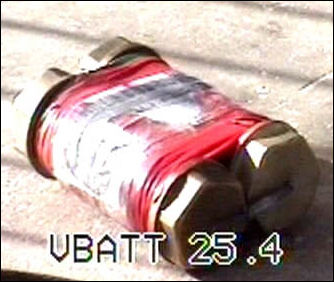
Pipe bomb found by
Israel Defense Forces Bombs can be placed in a bag and left somewhere. They can also be planted in parked car or truck that is used to ram a target. These days many terrorist attacks are carried out by suicide bombers.
A typical bomb contains about 10 pounds of explosives with nails, ball bearings, nuts, bolts, broken nails, rusty nails, scrap metal and/or screws as shrapnel. In some cases blood-thinning rat poison is added with the intent of making victims pierced by the shrapnel bleed to death. Sophisticated bombs use TATP (triacetone-triperoxide), a white powder chemical explosive that can be made at home, and PETN (pentaerythritol tetranitrate), a powerful explosive used in construction and the military that can be made into putty-like material. PETN is simple to produce but volatile and several bombmakers have been blown up trying to make it.
Instructions to how to make simple bombs can be picked up from the Internet or from widely available instruction manuals put out by terrorist groups. Simple bombs are made from acetone and phosphate (often obtained from fertilizer) mixed in bowl, left to dry, made into powder with a coffee grinder, and then packed into plastic bags or pipes. In pipe bombs the bombs explodes in the pipe and fragments of pipe become shrapnel.
Simple detonators can be made with a light switch, battery, and some wire. More sophisticated devices are connected to a cell phone and activated when a call to the cell phone is made. The detonators often activate TATP which in turn sets of the less combustible but more destructive main charge. TATP is very difficult to work with. It is one of the most sensitive explosives known. If you drop something against it or rub it it can explode. TATP has no commercial market. Terrorists like it because it can be made from ingredients found at a drug store or hardware store using recipes that are easily available on the Internet.
The chemicals, materials and electronics used to make a bomb can cost as little as $20. A prepared bomb costs as little $150. Some terrorist groups sell prepared suicide bomber beltpacks for between $1,500 and $4,000 depending on their quality, reliability and sophistication.
It is difficult ot make a bomb from gasoline or propane because what makes them explosive — the mix with air — is limited by narrow composition limits (two to nine percent). Molotov cocktails can make a big fire but they are not explosive.
Fertilizer Bombs
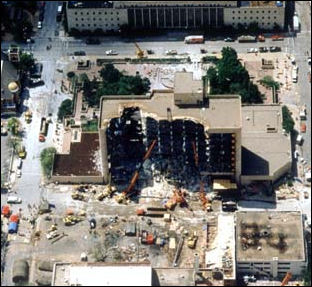
Oklahoma Murrah Building
destruction caused by fertilizer bomb
Terrorist groups have been using homemade explosives made from fertilizer for years. Craig Whitlock wrote in the Washington Post:. In February 1993, Islamic radicals drove a truck loaded with about 1,500 pounds of urea nitrate — a fertilizer-based explosive — and hydrogen-gas cylinders into a garage underneath the World Trade Center. The bomb killed six people and injured more than 1,000. Investigators determined that the cell built the bomb in New Jersey by consulting manuals brought from Pakistan. In 1993 Timothy J. McVeigh blew up the Alfred P. Murrah Federal Building in Oklahoma City with a truck bomb consisting of 5,000 pounds of fuel oil and fertilizer, killing 168 people. [Source: Craig Whitlock, Washington Post, July 5, 2007]
“Since then, it has become more difficult to purchase large quantities of fertilizer without attracting attention; sellers in the United States and many European countries are supposed to notify authorities of suspicious customers. The last known attempt by al-Qaeda to construct a fertilizer-based bomb in Europe came in 2003, when a cell operative bought 1,200 pounds of bagged Kemira GrowHow fertilizer for about $200 from an agricultural supply store in Britain. The salesman, John Stone, later testified that he thought the transaction was strange because it was the wrong time of year to apply the substance and the buyer claimed to have only a small garden plot. "I hope you're not going around bombing anything," Stone said he told the buyer half-jokingly, although the salesclerk did not notify police.
“British authorities were tipped off soon after, however, by an employee at a rental-storage center where the cell was keeping the fertilizer. In April, five members of the group were convicted in the plot, known as Operation Crevice. Many European fertilizer manufacturers have since reduced the amount of ammonium nitrate, a key bomb ingredient, in their products. Partly as a result, European and U.S. counterterrorism officials said terrorist cells are increasingly turning to peroxide-based explosives, which can be made in much smaller quantities from materials available at drugstores.
Spencer S. Hsu and Sari Horwitz wrote in the Washington Post: “Nearly 5 million tons of ammonium nitrate fertilizer are sold each year in the United States. None of it is regulated, although its explosive properties are used in mining and construction and by armies around the world. Government controls are resisted by farm and chemical lobbies, who say they would burden law-abiding citizens and not thwart terrorists. U.S. law permits farmers to mix it with fuel oil for personal demolition uses.”
In 2004 “the fertilizer industry urged ammonium nitrate sellers to voluntarily track sales and require buyers to show identification. But it resists any government regulation, and only Nevada and South Carolina have laws requiring tracking. The move followed a history of voluntary initiatives. In 1996, the Fertilizer Institute and ATF unveiled a "Be Aware for America" campaign after the Oklahoma City bombing, distributing 30,000 brochures and asking industry members to report suspicious activities. Kathy Mathers, spokeswoman for the Fertilizer Institute, said most fertilizer is sold in rural outposts. "These retail outlets and employees know their customers. A customer they don't know . . . will raise suspicions," she said. [Source: Spencer S. Hsu and Sari Horwitz, Washington Post, Sunday, August 8, 2004]
Car Bombs
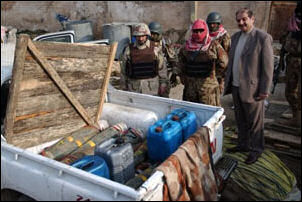
car bomb, Iraq Car bombs were a fixture of the violence in Lebanon. According to one report there were 3,641 car bombings which killed 4,386 people and wounded 6,784 in Lebanon during the period of civil war. Describing one car bomb attack in July 1983,Thomas Friedman wrote in the New York Times: “All car-bomb scenes start to look the same after a while. You stop noticing the stunned pedestrians with blood trickling down their cheeks who happened to be standing on the street when the lethal Mercedes — the favorite choice of Beirut car bombers — suddenly turns into a ball of flame. You stop seeing the smoldering charred carcasses of the other automobiles engulfed in the blast or the chaos of rescue workers as they scurry around on tip toe between the shards of glass and twisted car parts to pry out the dead and wounded.”
“Instead, after a while you find your mind focusing on the incongruities: the juicy roast chickens that were blown all over the street from an adjacent restaurant but somehow still looks good enough to eat, or the smell of liquor from a shelf full of broken Johnnie Walker bottles...I start to notice the leaves: when a car packed with 100 slicks of dynamite explodes on a crowded street the force of the blast knocks all the leaves off the tree and the road is left choking with them like an autumn lawn.”
“Life in this city is absurd not because people get killed but because they get killed playing tennis or lying on the beach or shopping in a market or driving home from work...Most Beirutis will tell you that of all the forms of violence they live with nothing terrifies them more than car bombs — not only because the are utterly indiscriminate, but because they transform a totally innocuous object from daily life into a daily weapon.”
Truck Bombs
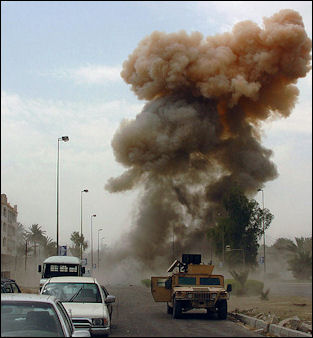
car bomb explosion in Iraq The truck bomb has been one of the destructive terrorist tools. Spencer S. Hsu and Sari Horwitz wrote in the, Washington Post: “Al Qaeda and other Muslim extremists have demonstrated mastery of the weapon. Since the first World Trade Center attack was plotted by Ramzi Yousef with 1,200 pounds of chemical explosives tied to Casio watch timers in a rented Ford van, al Qaeda cells perpetrated simultaneous truck bombings of U.S. embassies in Kenya and Tanzania in 1998, blew up three housing compounds in Saudi Arabia in May 2003, attacked resorts in Bali and Jakarta and carried out multiple bombings in post-war Iraq. In Britain, authorities recovered a half-ton of ammonium nitrate in March 2004, and in April, Jordanian officials disrupted a plan that involved tons of commercial fertilizer and two heavy trucks. [Source: Spencer S. Hsu and Sari Horwitz, Washington Post, Sunday, August 8, 2004]
"The truck bomb is a pervasive threat. Al Qaeda is adept at it and comfortable with it, and for all those reasons it is difficult to protect against it," Terrorist expert Bruce Hoffman told the Washington Post. "The lesson of September 11 was there's not a moment to lose, but we're constantly behind the curve. . . . We improve security, and it slows them down slightly, but it doesn't stop them." "If a person doesn't care about dying, they can pull right up to a building, push a button and the building would go," said Michael E. Bouchard, assistant director of the Bureau of Alcohol, Tobacco, Firearms and Explosives. "That's why we have checkpoints and try to keep large vehicles away from buildings.
On October 23, 1983, 241 U.S. Marines and 58 French paratroopers were killed in bombings that took place just three seconds apart at the Marine barracks in Beirut and a French facility three miles away. The attack on the Marines barrack was carried out by a suicide driver in yellow Mercedes truck laden with 12,000 pounds of explosives. The truck broke through gates of a compound near Beirut’s international airport and drove right into the four-story concrete compound used as the Marine battalion headquarters. Another suicide driver hit the French facility. No arrest were ever made and the terrorists are still believed to be in Lebanon. The United States left Lebanon in early 1984. The bombing of the U.S. Marine barracks in Beirut still ranks as the largest loss of American military life in a single incident since the Battle of Iwo Jima in World War II. After the American invasion of Iraq cement mixers packed with explosives rammed through gates and road blocks to reach their targets.
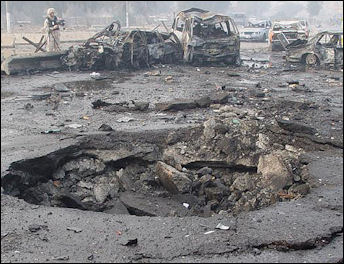
crater left by car bombing in Iraq Destructive truck bombings against American have not only been carried out by foreigners on foreign soil. Spencer S. Hsu and Sari Horwitz wrote in the Washington Post: “On April 19, 1995, disillusioned Persian Gulf War veteran Timothy J. McVeigh and Army washout Terry L. Nichols blew the face off the Alfred P. Murrah Federal Building in Oklahoma City with a 5,000-pound mixture of ammonium nitrate and fuel oil, killing 168 people.[Source: Spencer S. Hsu and Sari Horwitz, Washington Post, Sunday, August 8, 2004]
“The bomb was instructive in its power and ease of assembly. Equivalent to 4,100 pounds of dynamite, the blast damaged 312 buildings, cracked glass as far as two miles away and inflicted 80 percent of its injuries on people outside the building, up to a half-mile away. ATF officials had never studied the effects of a vehicle bomb larger than about 1,200 pounds, an ATF explosives expert said. The components came largely from a Kansas co-op. Nichols bought two tons of fertilizer in 50-pound sacks starting seven months before the attack. McVeigh also was careful to avoid detection, renting a Ryder truck from a Junction City, Kan., body shop one state away from his target.
Combating Truck Bombs
On some of the measures taken to address truck bombings Spencer S. Hsu and Sari Horwitz wrote in the Washington Post: Government bomb technicians have packed Chevrolet sedans, Dodge vans and Ryder trucks with 10 tons of explosives and have blown them up in the desolate New Mexico desert hoping to analyze the flight of debris over the sand. Federal agents in Front Royal, Va., have trained more than 400 Labrador retrievers to sniff out the chemical compounds used in 19,000 separate explosives formulas. Law enforcement officers have left thousands of calling cards across the country -- from a farmer's co-op store in McPherson, Kan., to a chemical company in West Haven, Conn. -- asking sales managers to report unusual interest in fertilizer or other components of homemade bombs. [Source: Spencer S. Hsu and Sari Horwitz, Washington Post, Sunday, August 8, 2004]
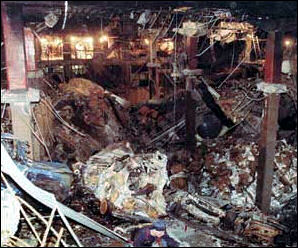
1993 World Trade Center bombing “The United States has spent more than $1 billion on these and other efforts to stop a single threat: the explosion of a car or truck bomb at a government installation or other structure. Since the 1993 World Trade Center bombing, the government has hardened federal buildings and military facilities at home and abroad; passed laws restricting the sale of explosives and shipments of hazardous materials; inspected thousands of people who deal with explosives; and researched explosive-detection and vehicle-disabling technology. But the only foolproof defense was on display last week, when heavily armed police sealed off buildings, roads and bridges in Washington, New York and Newark after the government issued an elevated terror alert focusing on five financial institutions.
“For four years in the 1990s at the White Sands Missile Range in New Mexico, government technicians wired vehicles with explosives and tracked the blasts' effects with high-speed cameras. In Florida and overseas, scientists conducted similar tests -- adding buildings to the destructive mix. Dubbed "Dipole Might" and funded by the National Security Council, the tests mapped the flight of debris as small as a matchbook, crater patterns and even the street sign-bending effects of blasts. Those experiments have become the basis of U.S. truck bomb forensics, allowing investigators to identify the type and quantity of explosive from studying the effects of the blast.
Liquid Explosives

Bombs Hidden in Basketballs
Israel Defense Forces Kenneth Chang and William J. Broad, New York Times, “Of the hundreds of types of explosives, most are solid and only about a dozen are liquid. But some of those liquid explosives can be readily bought, and others can be put together from hundreds of different kinds of chemicals that are not hard to obtain. Particularly worrisome are liquid explosives based on peroxide. The most common peroxide explosive is triacetone triperoxide or TATP (See Below). Other common liquid explosives include , like nitroglycerine and nitromethane — the fuel of dragster race cars — contain nitrogen compounds.
[Source: Kenneth Chang and William J. Broad, New York Times, August 11, 2006]
In 1995, a plot to bomb 12 American jumbo jets over the Pacific with a liquid explosive was discovered when the bomb makers accidentally set fire to their laboratory in Manila. Ramzi Ahmed Yousef, who was also involved in the World Trade Center truck bombing in 1993, was convicted in that case.
Neal Langerman, president of Advanced Chemical Safety, a consulting company in San Diego. Told the New York Times.”All of them are highly energetic,” he said of the various chemical combinations. “It doesn’t take much to punch a hole in the side of a plane, and if you punch a hole in the side of a plane, the plane comes down.”
TATP
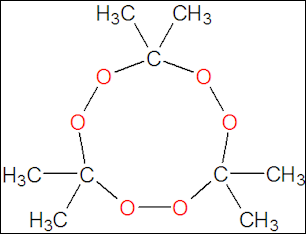
Craig Whitlock wrote in the Washington Post: “The most commonly used compound is triacetone triperoxide, or TATP. Primary ingredients for a homemade batch typically include acetone, which can be found in nail-polish remover, and hydrogen peroxide, a chemical used in hair-bleaching products. TATP wields about 85 percent of the explosive power of TNT and can be made in a kitchen or bathroom. A dime-size amount of the explosive can ignite a fireball the size of a basketball. According to Time terrorists like TATP because “recipes are all over the Internet, the ingredients can be found in any pharmacy, and it’s hard to detect.” [Source: Craig Whitlock, Washington Post, July 5, 2007]
Matthew L. Wald and Eric Lipton wrote in the New York Times: TATP “is made from two liquids: acetone, the primary ingredient of most nail polish removers, and hydrogen peroxide, commonly used as an antiseptic when diluted...TATP itself is a white powder made up of crystals that form when acetone and hydrogen peroxide are mixed together, usually with a catalyst added to speed the chemical reactions. But there is no need to wait for the crystals. ...Acetone is easy to obtain, hydrogen peroxide somewhat harder. The hydrogen peroxide solution sold in pharmacies is too dilute, only 3 percent, to be used in an explosive. Stronger hydrogen peroxide of 30 percent concentration can be ordered from chemical supply companies, but concentrations strong enough to generate a powerful explosion, about 70 percent, are not readily available, Dr. Langerman said. But acetone mixed with a 30 percent peroxide solution could still set off a fire that might burn through the aluminum skin of an airliner and cause it to crash, Dr. Langerman said. [Source: Matthew L. Wald and Eric Lipton, New York Times, August 11, 2006]
“The risky side of TATP is that it is highly unstable,” Whitlock wrote. “A spark or light friction can detonate the explosive, making it extraordinarily difficult to handle. Experts and police said there have been numerous cases in which suspected terrorists — as well as foolhardy amateur chemists — have set off accidental explosions, resulting in death or severe injuries. There is no commercial market for TATP. It is too hard to handle. A U.S. Bomb expert told Time, “TATP is one of the most sensitive explosives know. Drop something on it or run something against it, and it can go.” "You need to concentrate the chemicals," Hans J. Michels, a professor of chemical engineering at Imperial College in London, told the Washington Post . "It's a filthy job and it's dangerous, but it can be done." [Source: Craig Whitlock, Washington Post, July 5, 2007]
“Despite the dangers, al-Qaeda cells have used peroxide-based explosives in more than a dozen plots in the past decade, including the July 7 and 21, 2005, London incidents, as well as attacks in Casablanca, Istanbul and the Indonesian island of Bali, according to counterterrorism officials. TATP was discovered in the late 19th century but was deemed to have no industrial or commercial applications because it was so unstable. Researchers generally ignored the substance until 1980, when Palestinian fighters used it for the first time in a bomb in Israel. Palestinian bombers have used it ever since. TATP was used for the first time in an attack in Europe in July 1994, when Palestinians exploded a car bomb outside the Israeli Embassy in London. U.S. and European counterterrorism investigators paid limited attention to the explosive until the July 2005 bombings in London. Afterward, the New York City Police Department built an exact replica of the apartment in Leeds, England, that the July 7 conspirators allegedly used to manufacture their backpack bombs.

TATP powder “In crystalline form, TATP looks like powdered sugar and is difficult to detect in airports; security officials need to examine an exposed surface with a swab kit or other tester to determine its presence. "TATP and peroxide-based explosives are concern number one for the aviation industry," said Ehud Keinan, a chemistry professor at Technion-Israel Institute of Technology and a leading researcher on the substance. "It will take some time before we are protected. Right now, we are not."
“Keinan said he often carries a small sample of the volatile compound in his carry-on luggage when he flies -- just to test airport security. "Nobody ever stops me," he said. When asked if it might be dangerous to sit next to him on a plane, he said, "If you know how to take care of it, it's okay. If you don't know what you're doing, you're in trouble." U.S. Homeland Security officials have said terrorism suspects arrested last August in Britain on charges that they were plotting to blow up several transatlantic airliners might have been planning to smuggle on board TATP or a related compound, HMTD, hexamethylene triperoxide diamine. Experts said it would take as little as one or two quarts of those explosives to down a large plane.
Hugh O'Rourke, deputy inspector of the NYPD counterterrorism division, told the Washington Post the police department wanted to show beat officers what a kitchen-counter TATP production line would look like. He said it is easy to mistake the white powder and its cooking tools -- such as pool cleaners, large tubs or commercial-size fans -- for a common drug lab. "Patrol cops see a lot of white powder, think it's crack, and want to touch it and package it," which could easily result in an explosion, he said. "We don't want them doing that."
Efforts to Detect Liquid Explosives
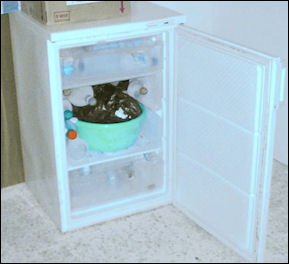
Explosives labs found
in private home Matthew L. Wald and Eric Lipton wrote in the New York Times: The U.S. government has “recognized the seriousness of the threat posed by liquid explosives and had been pushing aggressively to introduce equipment that could help. But no such devices are ready to be rolled out. In theory, scientists know how to detect peroxide-based explosives. The challenge will be to design machines that can perform the scans quickly and efficiently on thousands of passengers passing through security checks. “It will not be easy as the swab tests we are using for nitrogen compounds right now,” Dr. Langerman said. [Source: Matthew L. Wald and Eric Lipton, New York Times, August 11, 2006]
“Despite knowing for years that liquid explosives posed a threat to airline safety, security agencies have made little progress in deploying technology that could help defend against such attacks, security experts say. Since September 2001, the federal government has hired tens of thousands of government screeners and upgraded its metal detectors and X-ray machines. But most of the equipment is still oriented toward preventing a metallic gun or other easily identifiable weapon from being carried aboard; it cannot distinguish shampoo from an explosive.
“The department has been moving ahead with the installation of one proven technology, so-called puffer machines, which blow a small amount of air on passengers to look for traces of explosives... But these devices may not sound an alarm if a terrorist has been extremely careful in preparing the liquid explosive, meaning no traces are left on the container or the person or bag carrying it. And once on board, mixing the explosives would be “as easy as mixing a gin and tonic, if you have the right stuff,” said Paul Worsey, an explosives expert and professor of engineering at the University of Missouri at Rolla. Most liquid explosives would require a detonator, but a music player or other hand-held passenger gadget has sufficient electrical energy to do that, experts say.
“Without appropriate detection technology, the basic tool for now is big plastic garbage bags, which screeners were using to accept containers of shampoo, hand lotion and beverages that the Transportation Security Administration said were being “voluntarily surrendered” by people who packed their bags on Wednesday night, when those items were considered innocuous, and arrived at security checkpoints on Thursday morning, when they were considered “threat items.” Security officials also rescreened passengers at the gate at some airports.

“Finding the containers in carry-on bags is also not foolproof. “Pulling out liquid containers is a fairly easy step,” said Steven V. Lancaster, vice president of Guardian Technologies, of Herndon, Va., which makes detection equipment. But that presumes that the container was in a bag that went through an X-ray machine. The portals that screen people at the airports only detect metal. Hence being sure that there are no liquids will require more pat-downs of passengers.
“Guardian Technologies already makes software that analyzes the images produced by X-ray machines. Mr. Lancaster said that the Transportation Security Administration would begin testing, possibly next week, a new computer program that looks at the X-ray image pixel by pixel, far more carefully than the human eye could. The software can be set to sound an alarm when a specified number of pixels show a liquid (or solid) with a density that is characteristic of an explosive.
“Another vendor, Rapiscan Systems, a subsidiary of OSI Systems, which makes metal detectors and other equipment already used at checkpoints, is developing a liquids detector for the Department of Defense, according to Peter A. Kant, vice president of governmental affairs. The device, about the size of a newspaper vending box, bombards an object with subatomic particles called neutrons. Atoms hit by the neutrons give off a gamma ray characteristic of each atom. The machine can sense what part of a briefcase or other small object is giving off gamma rays characteristic of explosives, he said.
“Rapiscan is also developing a technology called quadropole resonance, that can be added to existing X-ray machines. An object is bombarded by radio-frequency energy. Objects being scanned resonate in a way that is particular to their chemical make-up, so individual chemicals can be scanned for. “We’re going to tell it’s not shampoo, suntan lotion, wine or water,” Mr. Kant said.
Shoulder-Fired Missiles
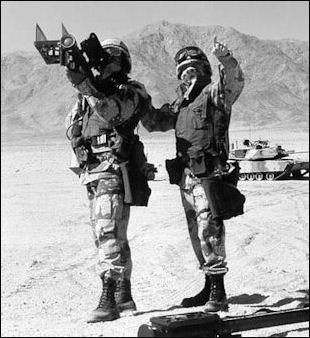
Stinger missile Shoulder-fired antiaircraft missile like the Stingers used in the Afghan-Soviet war in the 1980s and one used in attempt to shoot down an Israeli airliner leaving an airport in Mombasa, Kenya, in November 2002, are a concern. Some are compact enough that they are their firing tubes can fit into a golf bag.
Tom Zeller wrote in the New York Times: “The exact number of these shoulder-fired missiles — often called Man Portable Air Defense Systems, or Manpads — outside the hands of governments is impossible to know. A steady supply of stolen, traded or illegally purchased missiles moves through the shadow markets of arms dealers, while hundreds of others sit in the arsenals of at least two dozen insurgent and terrorist groups around the globe. Many are leftovers from past wars -- like those supplied by the United States to Afghan fighters during the Soviet occupation of the 1980's. [Source: Tom Zeller, New York Times, October 26, 2003]
“Shoulder-fired antiaircraft missile fall “into the category of really tough problems with no good solution,'' Charles V. Peña, the director of defense policy studies at the Cato Institute told the New York Times. That's because the equation is skewed in favor of anyone hoping to wreak havoc by launching a missile at an American plane: the weapons are relatively cheap (low-end models can be had for under $10,000) and plentiful, while potential deterrents, such that exist, are few and incredibly expensive. ''It wouldn't even have to hit anything,'' Mr. Peña said. ''Just having it known that a plane was fired on could be catastrophic for the airline industry, and it would have an effect that would ripple through the entire economy.''
“After terrorists armed with Manpads fired on an Israeli airliner leaving the airport in Mombasa, Kenya, November 2002, the level of concern about them rose. Many Manpads have a three- to five-mile range, and any rooftop, warehouse window or deserted street corner near urban airports becomes a potential launching site. The costs and logistical difficulties of adequately patrolling such areas would be extremely high. And retrofitting airplanes with antimissile technology would carry a multibillion-dollar price tag that, should the government decide to pay it, would raise questions about protecting other potential targets as well.
''Buildings are obviously targets too,'' Mr. Peña said. ''Does the government become responsible for securing every building over, say, 10 stories tall?'' The question highlights how combating terrorism has become something of a hamster wheel. Stamp out weapons of mass destruction and determined terrorists will turn to weapons of lesser destruction. Harden a target and they will aim elsewhere. And as the cost grows, which weapons remain threatening enough to pay for their elimination? Which targets will be worth shielding and which will be sacrificed to chance?
Stinger Missiles
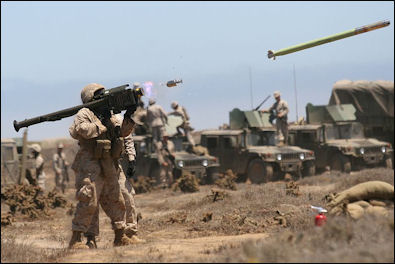
Stinger missile The FIM-92 Stinger is a personal portable infrared homing surface-to-air missile (SAM), which can be adapted to fire from ground vehicles and helicopters, developed in the United States and entered into service in 1981. Used by the militaries of the US and by 29 other countries, the basic Stinger missile has, to date, been responsible for several dozen attacks against civilian aircraft. It is manufactured by Raytheon Missile Systems and under license by EADS in Germany, with 70,000 missiles produced. It is classified as a Man-Portable Air-Defense System (MANPADS). [Source: Wikipedia]
Designed in the 1960s by General Dynamic, stingers were used in the Falklands War, Soviet invasion of Afghanistan, Angolan Civil War, Kargil War, Yugoslav Wars, and Invasion of Grenada. Costing about a $38,000 each, they are 1.52 meters long and 70 millimeters in diameter and can be fired by one person. Their effective range is 4.8 kilometers. Stingers have solid rocket motor engine and use infrared homing to lock on to targets. They can be fired by ground troops and from planes, helicopters and Predator drones.
Light to carry and easy to operate, the FIM-92 Stinger is a passive surface-to-air missile, shoulder-fired by a single operator, although officially it requires two. The FIM-92B missile can also be fired from the M-1097 Avenger and M6 Linebacker. The missile is also capable of being deployed from a Humvee Stinger rack, and can be used by paratroopers. A helicopter launched version exists called Air-to-Air Stinger (ATAS).
The missile itself weighs 10.1 kg (22 lbs.), while the missile with launcher weighs approximately 15.2 kg (33.5 pounds). The Stinger is launched by a small ejection motor that pushes it a safe distance from the operator before engaging the main two-stage solid-fuel sustainer, which accelerates it to a maximum speed of Mach 2.2 (750 m/s). The warhead is a 3 kg penetrating hit-to-kill warhead type with an impact fuze and a self-destruct timer.
To fire the missile, a BCU (Battery Coolant Unit) is inserted into the handguard. This shoots a stream of argon gas into the system, as well as a chemical energy charge that enables the acquisition indicators and missile to get power. The batteries are somewhat sensitive to abuse, with a limited amount of gas. Over time, and without proper maintenance, they can become unserviceable. The IFF system receives power from a rechargeable battery. Guidance to the target is initially through proportional navigation, then switches to another mode that directs the missile towards the target airframe instead of its exhaust plume.
Stinger Missiles and the Soviet-Afghanistan War
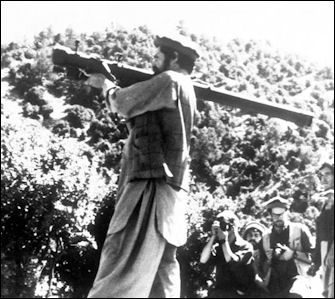
Mujahideen with MANPAD The story of Stingers in Afghanistan are told in many sources, notably Charlie Wilson's War by George Crile, and Ghost Wars by Steve Coll. In late 1985, several groups, such as Free the Eagle, began arguing the CIA was not doing enough to support the Mujahideen in the Soviet Afghan war. Michael Pillsbury, Vincent Cannistraro, and others put enormous bureaucratic pressure on the CIA to begin providing the Stinger to the rebels. The idea was controversial because up to that point, the CIA had been operating with the pretense that the US was not involved in the war directly, for various reasons. All weapons supplied at that point were non-US made weapons, like AK-47 rifles purchased from China and Egypt. [Source: Wikipedia]
The final say-so came down to Muhammad Zia-ul-Haq, the Pakistani dictator, through whom the CIA had to pass all of its funding and weapons to the Mujahideen. Ul-Haq constantly had to gauge how much he could "make the pot boil" in Afghanistan without provoking a Soviet invasion of his own country. Wilson and his associates at first viewed the Stinger as "just adding another component to the lethal mix we were building". Their increasingly successful Afghanistan strategy, formed largely by Michael G. Vickers, was based on a broad mix of weapons, tactics, and logistics, not a 'silver bullet solution' of a single weapon. Furthermore the previous attempts to provide MANPADs to the Mujahideen, namely the SA7 and Blowpipe, hadn't worked very well.
Engineer Ghaffar, of Gulbuddin Hekmatyar's Hezb-i-Islami, brought down the first Hind gunship with a Stinger in September 1986. The Central Intelligence Agency eventually supplied nearly 500 Stingers (some sources claim 1,500 to 2,000) to the Mujahideen in Afghanistan as part of Operation Cyclone. with the supply of 250 launchers. Some sources claim the Stingers had a decisive impact on the war, while other authors dismiss this argument. Whatever the impact on war may have been, certainly the Stinger proved extremely lethal against Soviet aircraft: 79 percent probability of kill from 269 kills in 340 engagements.
According to Crile the Stinger was a "turning point". Milt Bearden saw it as a "force multiplier" and morale booster. Charlie Wilson, the congressman behind US Operation Cyclone, described the first Stinger Mi-24 shootdowns in 1986 as one of the three crucial moments of his experience in the war, saying "we never really won a set piece battle before September 26, and then we never lost one afterwards".
After the 1989 Soviet withdrawal from Afghanistan, the US attempted to buy back the Stinger missiles, with a $55 million program to buy back around 300 missiles (US$183,300 each). The U.S. government collected most of the Stingers it had delivered, but some of them found their way into Croatia, Iran, Qatar and North Korea. According to the CIA, already in August 1988 the US had demanded from Qatar the return of Stinger missiles. Wilson later told CBS he "lived in terror" that a civilian airliner would be shot down by a Stinger, but he did not have misgivings about having provided Stingers to defeat the Soviets.
Beaheading Videos and Other Terrorist Propaganda Tools
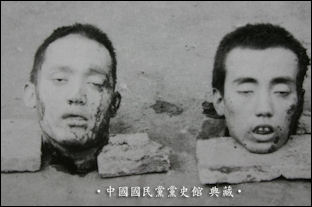
Beheaded revolutionists
in Wuchang, China
in the early 20th century Nicholas D. Kristof wrote in the New York Times: “Until you see a video of Iraqi insurgents taking a terrified, hogtied man and sawing off his head with a butcher knife, you don't know what "blood-curdling" truly means. Yet the jihadis themselves release these "beheading videos" on the Internet as part of their booming propaganda machine, and they are wrenching not only for their brutality but also because they underscore the insurgents' increasing technological edge. If there's any area where we should have the supreme advantage fighting terrorism, it's the Internet - yet Islamic extremists sometimes run rings around us in cyberspace, using it to recruit and train terrorists and to communicate with each other in amazingly sophisticated ways. [Source: Nicholas D. Kristof, New York Times, December 20, 2005]
“When insurgents stage an attack these days, they sometimes film it from several angles so as to make better propaganda, which they then distribute on jihadi Web sites and on DVD's. Aside from promotional videos like those, there are the how-to variety, like one with step-by-step instructions for making a suicide vest. At the end, the filmmakers made a makeshift bus and put the vest on a mannequin to blow it up. "The person who is wearing the explosive pouch, when entering the bus and wanting to blow himself up, his face must be to the front and his back to the rear," the video instructs. That's because there's much less explosive power on the sides.”
Mamoun Fandy wrote in the Washington Post: “The apparent executions in Iraq last week of U.S. soldier Keith Maupin and U.S. Marine Wassef Ali Hassoun, and the confirmed beheadings a week earlier of South Korean Kim Sun Il in Iraq and of American Paul Johnson in Saudi Arabia, left the media the world over horrified and uncertain about how much should be shown. Except in much of the Arab world, that is. As I scanned Arab satellite channels and Arabic newspapers, I found a lot of reporting on the brutal attacks, but very little condemnation and a widespread willingness to run the stomach-turning video and photos again and again. [Source: Mamoun Fandy, Washington Post, July 4, 2004]
“Showing videotapes of people being shot, beheaded or held hostage with a curved sword aimed at their neck is largely new terrain for the Arab media. As a media critic whose focus is the Arab world, I have watched perhaps a dozen Arab channels and read countless newspapers in recent weeks. I found that few Arab commentators and journalists noted either that major shift or its significance. In particular, the Kim and Johnson beheadings generally have been reported as if they were quite ordinary. (Hassoun's death was announced only yesterday by a militant group promising to release a video soon of his claimed beheading -- undoubtedly to wide coverage again.)
“I am aware of only a handful of columnists, most notably the Kuwaiti journalist Ahmed al-Rubai, who condemned the killings unequivocally. Some reporters and analysts intimated to me that they were afraid to denounce the beheadings; others provided distorted coverage that blurred the line between terrorism and Iraqi resistance to the U.S. occupation. Take, for example, the video of Kim's beheading. Al-Jazeera and the Lebanese LBC presented the video, which al-Jazeera said it had received from a group linked to al Qaeda, as if the terrorists were part of the Iraqi resistance against the Americans and their allies. Al-Jazeera did not note what any person knowledgeable about the region's dialects would have known: that the terrorists who appeared in the video and read the "verdict" that justified Kim's killing were not Iraqi and therefore not part of the Iraqi resistance. They clearly spoke a dialect from the Saudi heartland of Najd.
Beheadings in Iraq
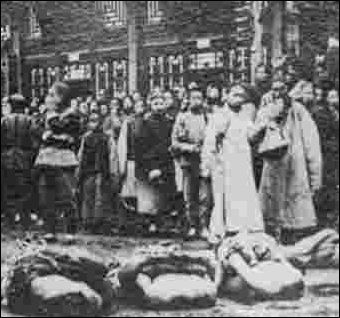
beaheaded corpses in Caishikou, China
in the early 20th century Beheading is a tactic sometimes used by terrorists — often quite effectively — to generate publicity and strike blood-chilling terror. More than a dozen kidnap victims and hostages were beheaded in Iraq after the American invasion there. The first widely publicized kidnaping and beheading was that of Nicholas E. Berg, a radio-tower builder from Pennsylvania who was abducted in April 2004 and beheaded while wearing an Abu Ghraid-style prison uniform, his killers said, to protest the treatment of Iraqi prisoners. His body was found hanging from a highway overpass on Baghdad.
Berg attended Cornell, did humanitarian work in Africa and was known as adventure seeker who loved to climb towers but was careless about his own safety in Iraq. A video of Berg’s decapitation was released on the Internet in May. It showed five, black-clad gunmen surrounding Berg. While one man holds him to the floor, another takes a knife out of his clothing and thrusts into Berg’s neck. A scream is heard before he is beheaded. When its is completed Berg’s head is held up to the camera. The man doing the actual cutting is thought to have been Zarqawi himself. The full video was shown on an Al-Qaida website. Television networks and newspapers around the world showed clips or shots before the beheading but no major network or newspaper in the Arab countries, Europe or the United States showed the beheading itself.
In September 2004, two American engineers — Jack Hensley and Eugene Armstrong — and a Briton were kidnapped in dawn raids to their home in of Baghdad’s most affluent neighborhoods. The three men worked for GSCS, a construction company based in the United Arab Emirates. A group linked with al-Zarqawi demanded that three women prisoners — including “Fr. Germ” and Mrs. Anthrax — be freed. Armstrong, Hensley and the Briton were beheaded. Armstrong’s beheading was posted on an Islamist web site. Hensley’s body and head were found in a plastic bag in Baghdad. Al-Zarqawi’s groups was thought to be behind the abductions and beheadings. Kenneth Bigley, a British engineer was taken hostage with two American engineers was also beheaded. On a video he was made a personal plea to Tony Blair to save his life, saying, “I need you to help me, Mr. Blair...Please, please help me see my wife who cannot go on without me. I don’t want to die. I don’t deserve it.”
In September 2004, three Kurdish hostages said to belong to a Kurdish party were beheaded by a group called Ansar al-Sunna on a video shown on the Internet. The victims were truck drivers captured in an ambush near Taji, 15 miles north of Baghdad. In the video a man wearing shorts, who is out of the picture takes large a knife and vigorously slices of the heads while blood pours on the ground and then places the heads back on the bodies. The three headless bodies were found by American soldiers on a road outside Mosul. A statement posted with the video of the beheadings blamed leaders of Kurdish political parties for pandering to Jews and Christians. In October 2004, a video was released that showed the slaying of 11 Iraqi guardsmen. The first was beheaded the others were shot. The men had been kidnapped a few days before. Ansar al-Sunna claimed responsibility. The same group beheaded Nepalese hostages in August.
Daniel Pearl Abduction and Beheading
On January 23, 2002, Wall Street Journal reporter Daniel Pearl was abducted by Muslim extremists. At around 7:00pm he got into a car outside a restaurant. He thought he was being taken to a meeting with a militant leader suspected of having ties with the shoe bomber Richard Reed. In fact he had been lured into a trap. Four photographs of Pearl and a message were sent as e-mail messages to a number of Pakistani and U.S. media organizations. One of the photographs showed Pearl with his wrists chained and a pistol pointed to his head. The e-mail messages were sent on Hotmail by “kidnapperguy.”
The kidnapers held Pearl for about a week. Their chief demands was that al-Qaida suspects being held at Guantanamo Bay in Cuba be returned to Borneo for trial. The United States government made it clear that these demands or any demands would not be met. Pearl was kept in a padlocked room in a nursery. He tried to escape by leaping over a 1½-meter mud wall fence when he went to an outhouse but was caught and roughed up a bit afterwards.
Pearl’s killers beheaded him and took a video of the murder, which was shown widely on the Internet. The killers forced Pearl to state that he was a Jew and that his mother and father were Jews, then his killers laid out their case against him and slit his throat and beheaded him, waving his head in front of a camera. The murder took place during the holiday that follows the Hajj in which sheep and other animals are sacrificed with a slit to the throat. Pearl’s throat was cut in the same manner as these animals.
The killers according to one Pakistani participant at the execution were three Arab men from Yemen. The witness said, “The Arabs came prepared. They had... a drop cloth and assorted knives.” After the killing the Arabs ordered the Pakistanis present to cut up the body into pieces and then left. The Pakistanis buried the body in a shallow grave outside the nursery.” Gravediggers found that the corpse had been dismembered into 10 pieces and laid flat in the grave with the severed head placed in an upright position at the base of the neck.
Terrorists Involved in the Daniel Pearl Execution
British-born Ahmed Omar Saeed Sheik was regarded as the mastermind of the Daniel Pearl abduction and execution. Saeed was educated in Britain and attended the London School of Economics. He spent six years in an Indian prison for kidnaping four foreign tourists that were held in Kashmir. He was released from prison in 1999 in accordance with a demand by the hijackers of Indian Airlines flight that was taken to Afghanistan that year. Saed is believed to have had connections with Al-Qaida. He was trained at an Al-Qaida camp in Afghanistan.
Saeed and three others were arrested in connections with Pearl’s murder. During the trial Saeed denied the charges, claimed he was framed by the United States and threatened the judge with assassination. One of the men arrested said that Pearl was killed because he was a Jew working against Islam and a CIA spy. All four men were found guilty. Prosecutors demanded that they be given a death sentence. Saeed was given a death sentence. The other three men were given sentences of life in prison. Members of the ISI, Pakistanis intelligence services are believed to have known more about abduction than they let on and hindered investigation of the crime,
There were some reports that Khalid Sheik Mohammed, the mastermind of the September 11th attack, was the one who beheaded Pearl. Mohammed bragged about doing it on the Internet then and in the testimony transcript..."I decapitated with my blessed right hand the head of the American Jew, Daniel Pearl, in the city of Karachi, Pakistan," he said. "For those who would like to confirm, there are pictures of me on the Internet holding his head.”
Dina Temple-Raston wrote in the Washington Post: KSM hadn’t initially been aware that the Pakistan bureau chief of the Wall Street Journal had been abducted by local hoods. “The kidnappers, panicked that they had gotten in over their heads, had contacted Al Qaeda colleagues of KSM, offering Pearl to them,” the authors write. “Al Qaeda offered $50,000 for him and, because it was in Karachi and Karachi was KSM’s territory, asked him to take possession of the prize.” [Source: Dina Temple-Raston, Washington Post , June 8, 2012]
Terry McDermott wrote in The New Yorker: “It was in Karachi that Mohammed encountered Daniel Pearl, the Wall Street Journal reporter. Pearl, who was based in India, went to Karachi in January, 2002, to research a story on Richard Reid, the “shoe bomber,” and his connections to Pakistani jihadi networks. Pearl arranged to meet with someone he thought was a member of the networks. The meeting didn’t take place; instead, he was kidnapped, held for ransom, and killed. A video posted on the Internet showed Pearl’s severed head held by what some believe is Mohammed’s hand, recognizable by the “extra meat” on his ring finger, as a Filipino investigator once put it. [Source: Terry McDermott, The New Yorker, September 13, 2010]
“There remains a debate about whether Mohammed in fact committed the killing. Pakistani investigators now think that he did, though he had nothing to do with the initial kidnapping; that was the work of what one investigator called a “mishmash” of local jihadis. Some of them came from the Kashmir struggle. Some, such as Omar Saeed Sheikh, who has been convicted of planning the kidnapping, were experienced both in Kashmir and in kidnap-and-ransom operations. Western media latched on to the story, and the kidnappers, who apparently did not anticipate the attention that the crime would attract, had no idea how to resolve the situation. This is where Mohammed is believed to have stepped in. “Khalid Sheikh Mohammed got to know of the plot, which he had done nothing to serve,” a senior Pakistani police official said. “He got to know of it through the grapevine. And so he said, “This is great, a chance to do something spectacular.” So he basically bought Daniel Pearl from them. He gave them fifty grand, bought Daniel Pearl, got a guy with a camera, and the rest is history.” The killing was wanton and opportunistic; Pearl just happened to be available to him.”
History of Beheadings
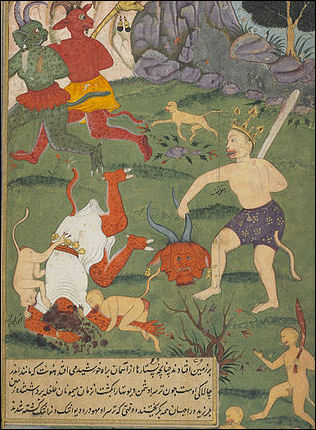
Hanuman beheads Trisiras
from Hindu mythology Steve Mufson wrote in the Washington Post: “From the headless corpses of North African warriors lined up before ancient Egypt's Temple of Horus about 5,000 years ago to Kim Sun Il, the South Korean interpreter killed in 2004 in Iraq, perhaps no method of execution arouses as much fear and revulsion as beheading. And usually that's just the effect its practitioners — whether monarchs or terrorists — want it to have. Beheading is the latest weapon in the hands of those who have sworn to punish Westerners, but it has a long history. It has been used from Medina to Manchuria, from Norway to Nigeria. [Source: Steve Mufson, Washington Post, July 4, 2004]
“When U.S. citizen Paul Johnson was beheaded by terrorists in Saudi Arabia in 2004, six Saudi clerics issued a statement that said: "The bombings and killings have revolted people and hurt individuals and their property, and no one with the slightest knowledge of Islam can doubt that this is an atrocious crime and grave sin." But in their eyes, the sin was the improper taking of a life, not the method. The Saudi government beheaded 52 men and one woman last year for crimes including murder, homosexuality, armed robbery and drug trafficking.
Is beheading un-Islamic? The Koran (chapter 47, verse 4) says: "When ye meet the Unbelievers in battle, smite at their necks; At length, when ye have thoroughly subdued them, bind a bond firmly on them: thereafter is the time for either generosity or ransom: Until the war lays down its burdens." According to some accounts, in 627 A.D., the prophet Muhammad approved the beheading of 600 people from a Jewish tribe living near Medina. He believed tribe members had betrayed him by negotiating with his enemies. "In 680, the prophet's favorite grandson, Hussein bin Ali, had his head chopped off in Karbala in central Iraq by the soldiers of the Caliph Yazid," Iranian-born journalist Amir Taheri wrote in a New York Post column. "The severed head was put on a silver platter and sent to Damascus, Yazid's capital, before being sent further to Cairo for inspection by the Governor of Egypt."
“Today, beheading is still used officially in a handful of Persian Gulf countries, including Saudi Arabia and Iran. Historically, the practice was not limited to Muslim countries. The Romans used it; the Book of Revelation cites "the souls of them that were beheaded for the witness of Jesus, and for the word of God."Some cultures considered beheading to be a quicker -- and, therefore, more humane and honorable -- method of execution than the alternatives, such as hanging, crucifixion or disemboweling. In England, beheading was introduced in 1076 and restricted to those of noble birth convicted of treason. When Sir Thomas More was convicted of that crime in 1535, his sentence was "that he should be . . . hanged till he should be half dead; that then he should be cut down alive, his privy parts cut off, his belly ripped, his bowels burnt, his four quarters set up over four gates of the City, and his head upon London Bridge." King Henry VIII commuted the sentence to beheading. As a warning to others not to defy the king's will, as More had by refusing to take an oath recognizing Henry's supremacy to the pope, More's head was indeed placed on London Bridge, where it stayed for several months.
“But the punishment has not always been swift, or humane: It took three blows to remove Mary Queen of Scot's head in 1587.Many of the countries at the forefront of human rights campaigns today once used beheading as a form of execution. In Sweden, about 600 people, including nearly 200 women, were beheaded in the 19th century.In Japan, beheading was frequently performed as the second part of ritual suicide. The person committing suicide would disembowel himself and a trusted friend would then decapitate him with a katana, or long single-edged sword. Japanese warriors also cut off the heads of their enemies for many centuries. Beheading was one charge in the war crimes case against Japanese leaders for the 1928 massacre of more than 200,000 people in Nanjing during Japan's occupation of China.
“Historically, axes or swords have been the instrument of choice. The guillotine (named after Joseph-Ignace Guillotin, a French doctor and member of the Revolutionary National Assembly) was first used in France in 1792 to execute a highwayman. The next year it was used to execute the queen, Marie Antoinette. But many countries continued to use axes or swords. Germany used axes to decapitate criminals through the 1930s. In 1935, a baroness and her friend were convicted of spying and their heads were chopped off by an executioner wearing tails, top hat and white gloves. More recently in Iran, the mullahs have cut off the heads of some political figures. The Beirut CIA station chief William Buckley was kidnapped by Hezbollah and sent to Iran, where he was beheaded in 1986. Agents were sent to cut off the heads of the shah's last prime minister in a Paris suburb in 1992 and an Iranian pop star in Germany in 1993.
“Now that most governments have given up the practice, terrorist groups from Nigeria to the Philippines seem to have adopted it. While Iraqi insurgents and al Qaeda's offshoots have made beheadings something of a trademark lately, they aren't the first extremist groups to engage in the gruesome tactic. In Algeria in the 1990s, according to Human Rights Watch, members of the Islamic Armed Group (Groupe Islamique Armé, or GIA), "exhibited spectacular cruelty. In addition to guns, they used crude weapons such as knives and saws to behead or disembowel men, women, and children."According to Taheri, the GIA recruited Momo le Nain ("Muhammad the Midget"), a butcher's apprentice, for the purpose of cutting off people's heads. In 1996 in Ben-Talha, a suburb of Algiers, Momo cut off 86 heads in one night, including those of more than a dozen children.
Image Sources: Wikimedia Commons
Text Sources: New York Times, Washington Post, Los Angeles Times, Times of London, The Guardian, National Geographic, The New Yorker, Time, Newsweek, Reuters, AP, AFP, Wall Street Journal, The Atlantic Monthly, The Economist, Global Viewpoint (Christian Science Monitor), Foreign Policy, Wikipedia, BBC, CNN, NBC News, Fox News and various books and other publications.
Last updated July 2012
